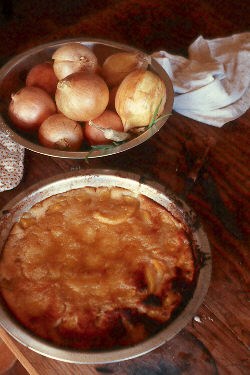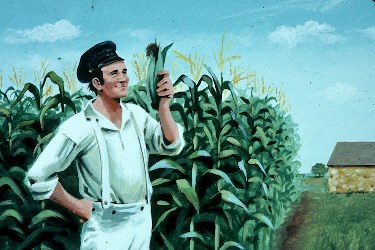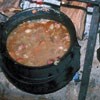
In the 1840s American West, the acquisition and cultivation of food was a necessity of life that was common to the settlers, soldiers and emigrants. The soldiers were more fortunate than the civilians because the army supplied their basic food (rations). The settlers and emigrants had to acquire their own food through cultivation, hunting, fishing, trading or by purchasing it. The Subsistence Department of the Army was responsible for the acquisition, quality, and distribution of the rations and related ingredients (flour, sugar, salt, vinegar, molasses, etc.). At each post an officer was assigned as the Assistant Commissary of Subsistence and was responsible for maintaining a sufficient supply of rations for the garrison. The bulk of the rations and related ingredients were stored in the Post Commissary building and only the proper amounts were distributed (issued) to each company of soldiers. A soldier's basic rations consisted of specified amounts of meat (pork or beef), bread, peas or beans, rice or hominy, and coffee. Related ingredients such as salt, sugar, vinegar, pepper and molasses were also issued as rations to assist with the preparation of the food and enhance the bland military diet. During the 1840s, the United States Army did not have any permanent cooks or bakers. Cooking was considered to be a regular fatigue (work) detail which was performed by two enlisted soldiers from each company for two weeks. The biweekly rotation and individual experience of the cooks and bakers caused the quality of the food to vary, but as long as it was prepared according to the regulations the army considered the food to be edible. If a cook was satisfactory and desired to remain longer, arrangements were made to keep him on, and he was relieved of his other duties, sometimes for months. Although a cook received no extra pay, he had the privilege of selling soap-grease, if there was a market for it. Bread and soup were the major items of the enlisted soldiers' diet. The bread was baked in the Post Bake-House and was not issued until it had become stale. Stale bread was considered to be more nutritious and digestible than fresh bread. Regulations required that dried vegetables (peas, beans, etc.) had to be soaked in cold water before boiling and soup had to be boiled for at least five hours before it could be served. Meat was boiled, roasted, or baked, but never fried because fried food was considered harmful. Regulations also specified that fresh meat was not to be cooked until it had time to bleed and cool. One medical officer pointed out the difference between dried meat of the Indian or voyageur (jerky) and the dried meat of the soldier (salt meat) was chiefly that jerky merely lost the watery portions, while the salt meat contained "kreatine," which was soluble in brine but retained little nutrition in the contracted and solidified mass known as salt junk. The latter could be either beef or pork, but it was, "employed as food upon much the same principle as that ascribed to alligators, who swallow stones to appease the cravings of an empty stomach." 
The soldiers supplemented their monotonous rations with the meat of wild animals (deer, rabbit, squirrel, etc.), fish, and vegetables that were cultivated in the gardens at the fort. The following vegetables were raised at various military posts on the frontier from 1820 to 1850 and were probably raised in the gardens at Fort Scott: potatoes, onions, beets, cabbage, radishes, turnips, lettuce, greens, mustard, squash, cucumbers, peas, green beans and corn. The men were encouraged to grow gardens to supplement the army rations. Since a well-fed soldier usually was a contented soldier, attention was paid to the diet. At Fort Scott, Croghan was able to report that the, "post gardens being good, the fare is of course equal to every wish of the soldier." The army had early learned its lesson in regard to proper nutrition. Despite its claim that the, "two great scourges of camp life, scurvy and diarrhea," resulted from a lack of skill in cooking rather than from the ration, over 150 men had died the first year in Fort Atkinson, Nebraska, when they were forced to subsist a winter without vinegar or vegetables. Only the appearance of the wild onion in the spring saved the command. Wild onions, vinegar, and other fruits and vegetables contain vitamin C which prevents scurvy. One of the main differences between the soldiers and civilians on the frontier is that the army provided the soldiers with their food while the civilians had to struggle to survive. Army food was often poorly cooked and monotonous, but it was consistently available. The soldiers did not have to depend on a successful hunt or crop for their food, but very often these were facts of life for the civilians. As a result of this, many of the civilians believed that the army provided the soldiers with too much and that they had an easy life. Information for this page came from the Historic Furnishings Report:The Dragoon Barracks by Sally Johnson Ketchum and from an anonymous article written by a staff member at Fort Scott NHS. |
Last updated: July 30, 2016

